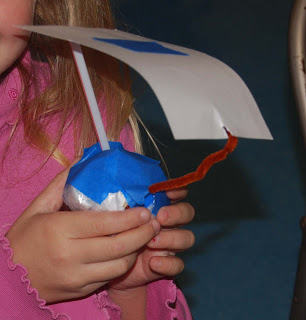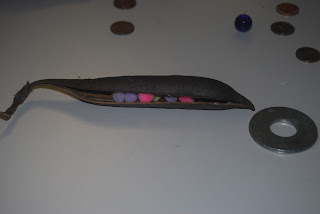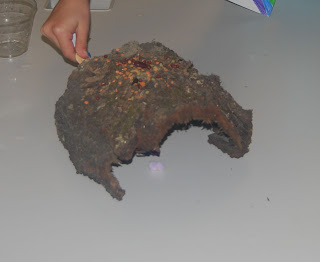Within our 45 minute session, we told the children that they must design a safety device for Humpty Dumpty given the set of parts that were provided. The parts can vary, but this year we included:
- a straw
- a paper clip
- an index card
- a 4x4" piece of bubble wrap
- 2 cotton balls
- 6 inches of pipe cleaner
- 3 or 4 pieces of styrofoam peanuts
- and 12 inches of tape.
Last year we included a small cup, and none of our hard boiled eggs cracked. This year I decided to replace the cup with the index card. The results did change.
The designs varied to some degree. Some groups were more engaged than others. Often the kids just wrapped up the egg in some form of another without real thought to how to protect the egg. One of these designs is shown below. Some of these groups only used a few of their materials.
Other groups used all of their materials and had an approach of putting everything in a somewhat haphazard manner. Sometimes these designs worked, sometimes they didn't.
Another common approach was to build something that looked like a paper can. Most of the time this design was not so successful. The kids tended to protect the top and bottom of the egg, but neglected the sides which cracked in the drop.
The photo below shows our most innovative design. The kids wanted to design a parachute. I had my doubts about its success, however the egg survived with no cracks!
On average of the six groups in each class, only two were able to prevent Humpty Dumpty's demise, and the rest were cracked to some degree. The kids were all good natured about it, save one girl who did cry when her team's egg was cracked. However, having the boys cheering for cracked eggs probably did contribute to this situation. In most classes, the kids cheered for all the teams and were good natured about the whole process.
The wall we used was built from card board bricks and taped down. We rolled the designs off, and then opened them up to see how Humpty Dumpty fared. We used boiled eggs, which did cause a few kids some confusion. Those kids that had not had experience with boiled eggs were confused as to why the yolk didn't run out when they were cracked.
Overall, this activity went well. I think next year I would eliminate the peanuts in favor of a different soft material. Some of the kids could not help buy shred the peanuts, and I spend 15 minutes or so cleaning up the mess afterwards! So, I would recommend forgoing peanuts. As in all of the activities, it is a lot to pack into 45 minutes. However, this is all the time that their schedules allow. If we had more time, we would have the kids redo their designs and try again. We did discuss how engineers design and test and redesign all the time. That is part of their design and learning process.
The kids love this activity, and it is one that we will keep doing.
The wall we used was built from card board bricks and taped down. We rolled the designs off, and then opened them up to see how Humpty Dumpty fared. We used boiled eggs, which did cause a few kids some confusion. Those kids that had not had experience with boiled eggs were confused as to why the yolk didn't run out when they were cracked.
The last innovative design I want to show is the one below. These kids built a type of spring out of the pipe cleaner and the straw. The concept worked well, and kind of bounced on the floor, and prevented the egg from cracking.
The kids love this activity, and it is one that we will keep doing.






















